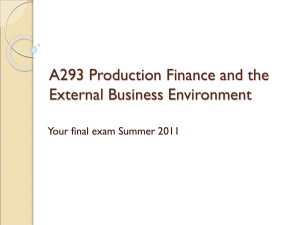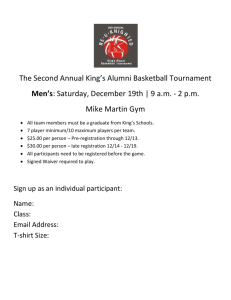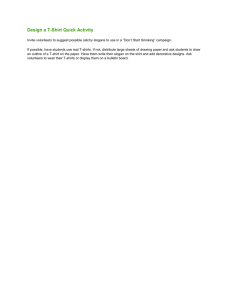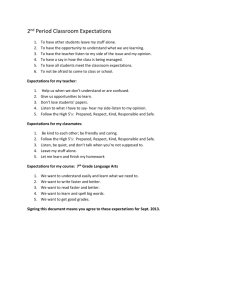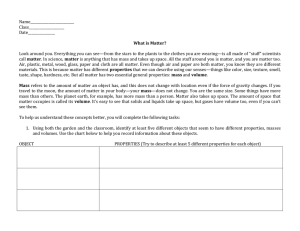Introduction to Consumption and Waste: Round the Room Activities
advertisement
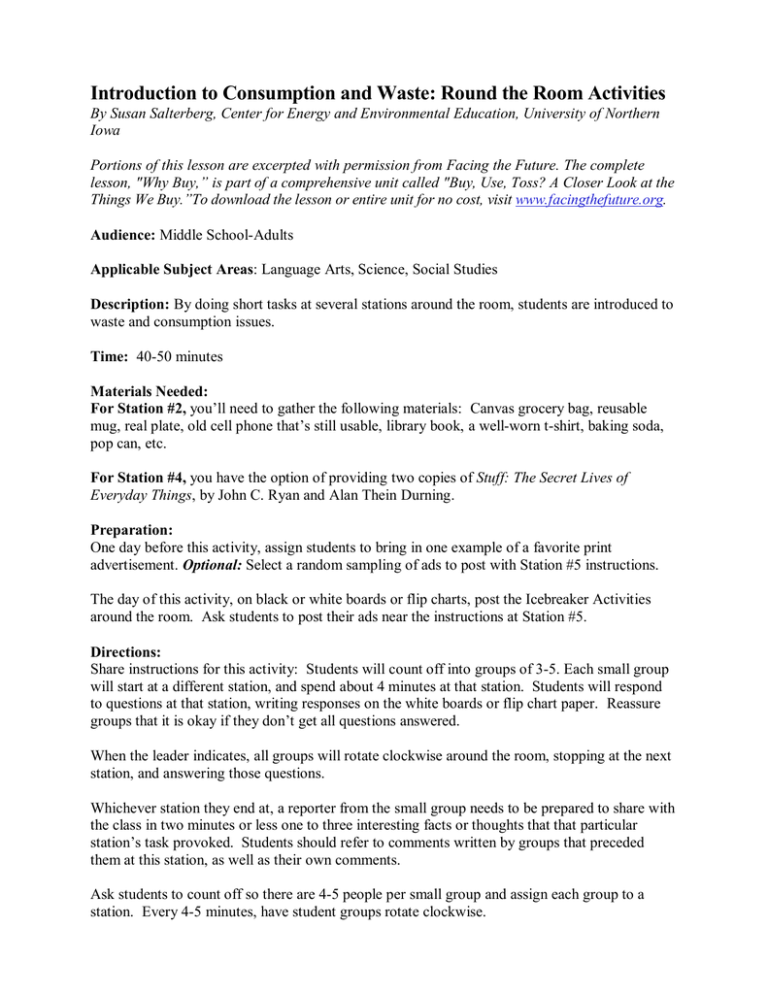
Introduction to Consumption and Waste: Round the Room Activities By Susan Salterberg, Center for Energy and Environmental Education, University of Northern Iowa Portions of this lesson are excerpted with permission from Facing the Future. The complete lesson, "Why Buy,” is part of a comprehensive unit called "Buy, Use, Toss? A Closer Look at the Things We Buy.”To download the lesson or entire unit for no cost, visit www.facingthefuture.org. Audience: Middle School-Adults Applicable Subject Areas: Language Arts, Science, Social Studies Description: By doing short tasks at several stations around the room, students are introduced to waste and consumption issues. Time: 40-50 minutes Materials Needed: For Station #2, you’ll need to gather the following materials: Canvas grocery bag, reusable mug, real plate, old cell phone that’s still usable, library book, a well-worn t-shirt, baking soda, pop can, etc. For Station #4, you have the option of providing two copies of Stuff: The Secret Lives of Everyday Things, by John C. Ryan and Alan Thein Durning. Preparation: One day before this activity, assign students to bring in one example of a favorite print advertisement. Optional: Select a random sampling of ads to post with Station #5 instructions. The day of this activity, on black or white boards or flip charts, post the Icebreaker Activities around the room. Ask students to post their ads near the instructions at Station #5. Directions: Share instructions for this activity: Students will count off into groups of 3-5. Each small group will start at a different station, and spend about 4 minutes at that station. Students will respond to questions at that station, writing responses on the white boards or flip chart paper. Reassure groups that it is okay if they don’t get all questions answered. When the leader indicates, all groups will rotate clockwise around the room, stopping at the next station, and answering those questions. Whichever station they end at, a reporter from the small group needs to be prepared to share with the class in two minutes or less one to three interesting facts or thoughts that that particular station’s task provoked. Students should refer to comments written by groups that preceded them at this station, as well as their own comments. Ask students to count off so there are 4-5 people per small group and assign each group to a station. Every 4-5 minutes, have student groups rotate clockwise. When finished, ask each group to identify a reporter who will share 1-3 interesting facts from their current station or thoughts that particular station’s task provoked. Students should refer to comments written by groups that preceded them at this station, as well as their own comments. When Station 2 is discussed, you may wish to provide some additional explanation or questions to elicit problem-solving from students. Station 2 Explanation: Students will be asked to identify why these are examples of waste reduction. The canvas bag and mug are obvious. The real plate is a similar example of using an item over and over (instead of using paper or plastic disposable plates in this case). An old stillused cell phone is an example of waste reduction, because it is not buying something when an existing item still is usable. The well-worn t-shirt is an example of using something over and over. The t-shirt is highlighted, because Americans have opportunities to buy new t-shirts many times in a given year…on vacations, at sporting events, etc., etc. When a citizen forgoes the purchase of a new t-shirt, they are practicing waste reduction. The library book is an example of waste reduction, because it allows people to read books without buying them. Baking soda may be used to clean instead of a toxic cleaner. A pop can is an example of a redesigned product. According to Stuff: The Secret Lives of Everyday Things (pg. 64), design improvements have made cans one-third lighter than they were in 1970. Examples of design features: the bottom of the can arches inward so that the can’s walls can be made thinner. (If the bottom wasn’t bowed, a carbonated drink would make the can bulge and tip over.) Most cans are tapered by about 10% at the top to save aluminum. Extension: Further discussion by asking students “Do the ads provide you with the information that’s most important to you when deciding whether to buy the product? If not, why do you think that information is missing?” STATION 1: List all trash items you discarded in the past two days. Start two days ago as soon as you woke and got out of bed. Include items any of your group members mention, and make tally marks by items discarded by more than one of you. Also include tally marks for each time this product was discarded. For example: o Cup 1111 = 5 students, 1 time/student o Hamburger bun 1111 = 4 students, 1 time/student or 3 students, 1 time/student except one student threw away 2 buns in the two days o Toothpaste 1111 1111 111 = 13 students, 1 time/student STATION 2 (Bag of materials included at this station.) Recycling means “to use again after re-processing.” List 3 materials that can be recycled in your communities. Reducing waste—a much more difficult concept to grasp—means “to prevent the generation of waste.” This may include: redesigning products or packaging to use less material increasing product durability reducing the use of toxic constituents using a product until it’s worn out Examine the items in the bag, and discuss why each of these is an example of waste reduction. If you have time, identify other examples. STATION 3 List some products/materials you’ve already consumed or used today. List some ways you’ve already reduced consumption or waste in the past week (i.e., did you car pool, use your own coffee mug versus disposable mug(s), wear either clothing that is used or usedwell-by-you, turn off lights not in use). STATION 4 (Optional: 2 copies of Stuff book) Do you know the chain of production or life cycles of your stuff? For starters, name some of the natural resources used to create these products. 50% cotton/50% poly French fries Computer t-shirt Optional: If you have time, use the book Stuff: The Secret Lives… to investigate one of the products listed above. Identify some of the points mentioned in the book that surprised or interested you about that product. STATION 5 (Include samples of advertisements from students.) Skim the advertisements on the wall. Vote whether you Agree or Disagree with the statement: “The goal of advertisements is to make us unhappy with what we have.” All members of your group should vote individually: AGREE DISAGREE Then answer the following additional questions: In what ways does advertising influence consumption? If you were from another part of the world and you knew of the US culture only from watching American commercials and seeing American print advertisements, what would you think are the most important values of our society?
